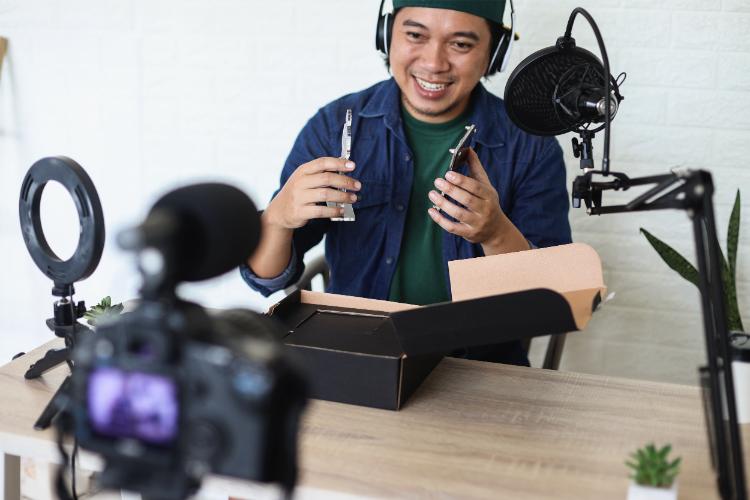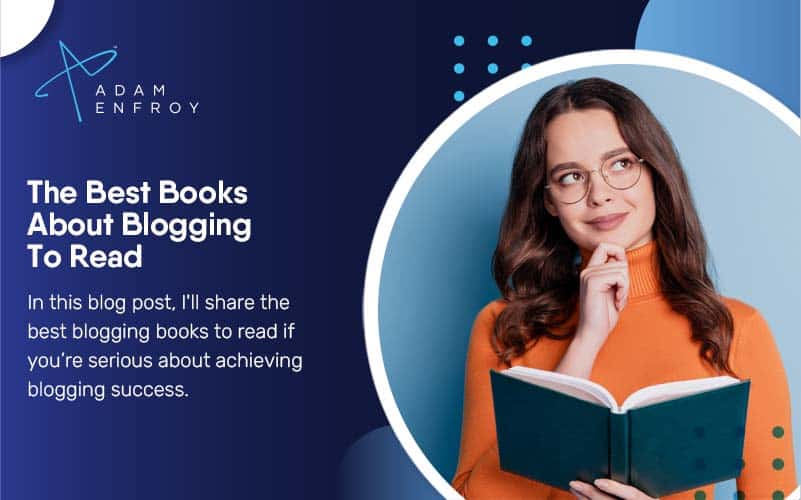How To Write An Amazing Blog Post That Attracts Readers in 2024
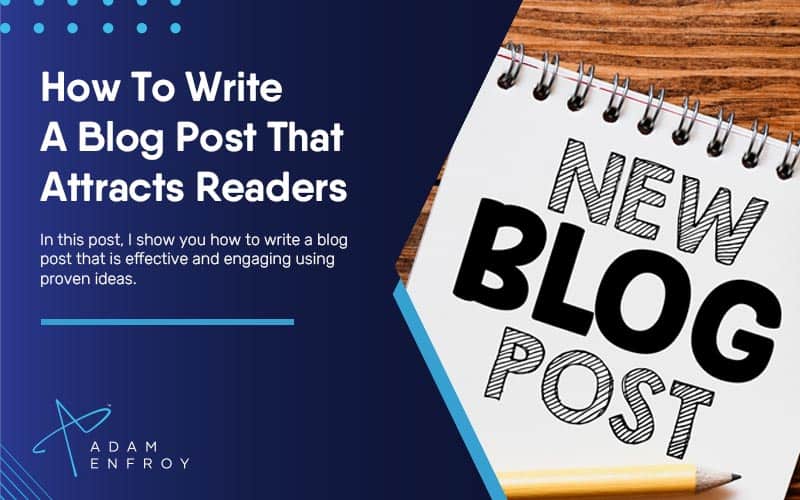
When starting a blog, sitting down to write a blog post can seem overwhelming.
It’s easy to get caught up in the logistics of the process, creating engaging content and ensuring that all the elements of a blog post are in place.
In this post, I will show you how to write a blog post that is effective and engaging by following a proven framework and ideas that work every time.
The Three-Step Framework
Here are the three steps to follow when writing a successful blog post.
Brainstorming Ideas
Brainstorming is essential when creating any content, but especially when creating blog posts.
A great way to get started is by sitting down with a pen and paper (or your laptop) and writing down whatever comes into your head.
Whether you’re writing your first blog post or your hundredth, brainstorming can be a great way to develop original ideas that capture your audience’s attention.
With plenty of online mind maps and tutorials to help you brainstorm exciting blog topics, you can quickly start with a few simple ideas.
Creating Content
Once you’ve developed some ideas for your blog post, it’s time to start writing.
Try writing in short bursts throughout the day rather than trying to do it all at once, so you can maintain focus and enthusiasm for the project.
Writing perfect blog content is as much an art form as it is science and takes practice.
The more you write, the better you’ll get.
Consider what your audience wants to know or learn from your post when creating content.
Writing content for a blog post is also a great way to increase content marketing and on page SEO efforts, as you can strategically add keywords that search engines will pick up.
Also, make sure that you are well aware of the tone/voice of your posts, as this will be one of the critical factors in making them successful.
Use a conversational tone and make sure to add some humor where appropriate.
Finally, edit your work or have someone else review it before publishing.
Having another set of eyes look over your work can help catch any errors or typos you may have missed during editing.
Promoting Your Blog Post
Consistency when writing a new blog post is excellent – but it’s only half the equation.
Promotion is the other half.
You can promote a blog post in many ways, and social sharing using platforms such as Facebook or Twitter is a great way to get started.
You can also build guest posts on other websites and link to your blog.
Don’t forget about email newsletters, a great way to send announcements when publishing new content.
If this sounds like a lot, don’t worry!
We’ll now get more granular and look at various strategies you can employ at each stage of the blog post creation process.
Finding Low-Volume Keywords for Your Website
Targeting a low-volume keyword is critical when optimizing your website for search engine success.
After all, if you’re looking to increase your website traffic, you want to target something other than high-traffic keywords with thousands of monthly searches.
If so, you’ll compete with too many websites and won’t stand out.
Instead, if you want to scale your influence, you should look for 10-150 monthly searches that are more specific and will help you rank higher in search engines.
But how do you do the perfect keyword research?
A tool like Ahrefs can be the first step toward finding the perfect low-volume keyword.
With Ahrefs, you can quickly identify the keyword type (short-tail or long-tail) and check its monthly search volumes.

Start by focusing on a few blog post ideas and researching related keywords to find the best low-volume keyword in your niche.
For example, if your blog post is about “cooking tips,” searching for “how to cook better” might reveal a better keyword with fewer monthly searches.
Once you have identified the broad topic, it’s time to start researching more specific keywords for your website.
Understanding User Search Intent
Writing that first blog post (or your 100th) can be challenging, but understanding user search intent can take your blogging website far.
User search intent refers to the user’s goal when they type a keyword or phrase into a search engine.
The best way to understand user search intent is to research keywords before writing your blog post.
Check out what other articles appear in the search results when you type in the keyword or phrase you plan to use for your article.
Ask yourself:
- What kind of content are people looking for when they search for this keyword?
- Are the articles more informational, or do they focus on product reviews?
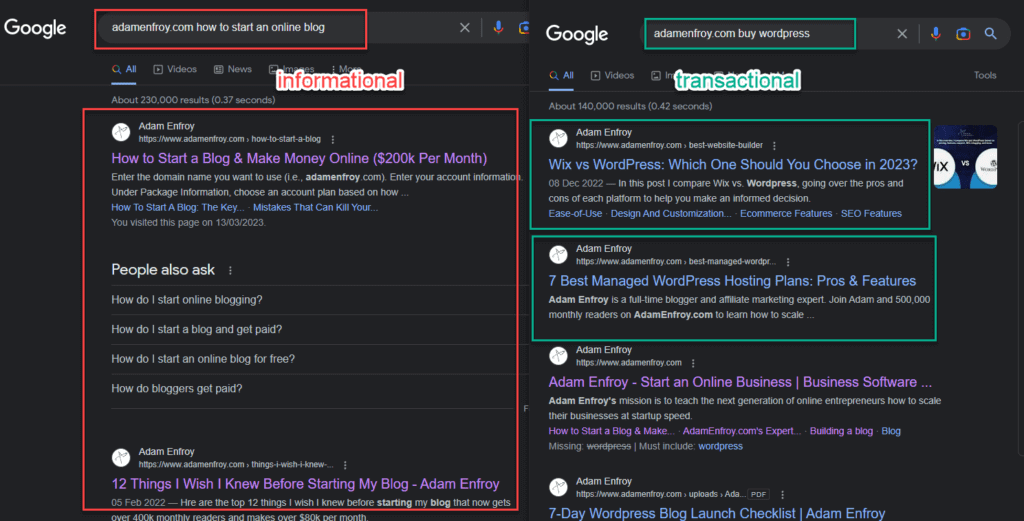
When you answer these questions, you can take the main points of your topic and research keywords to understand better what type of blog content people seek.
Optimizing the post for relevant search terms will help readers interested in those topics find your blog post and increase website traffic.
Moreover, tasks like finding subheadings and using appropriate images become easier as you ensure you create the right content.
Write An Attention-Grabbing Headline
A great headline is necessary if you want a great blog post that succeeds.
Accurately summarizing your topic in the blog title of your post can go a long way.
Try to make sure that the title of your blog post accurately describes the content it’s covering while also sounding interesting enough to grab readers’ attention.
Use your chosen keyword in the title and make it catchy, creative, and exciting.
Your headline should be enticing enough to make people want to click on your post and read more.
Think of headlines as an opportunity to grab your reader’s attention.
Try using words that evoke strong emotions like ‘amazing,” ‘incredible,” or ‘must-read.”
Doing so will depend on your industry but knowing the powerful words that attract readers is essential.
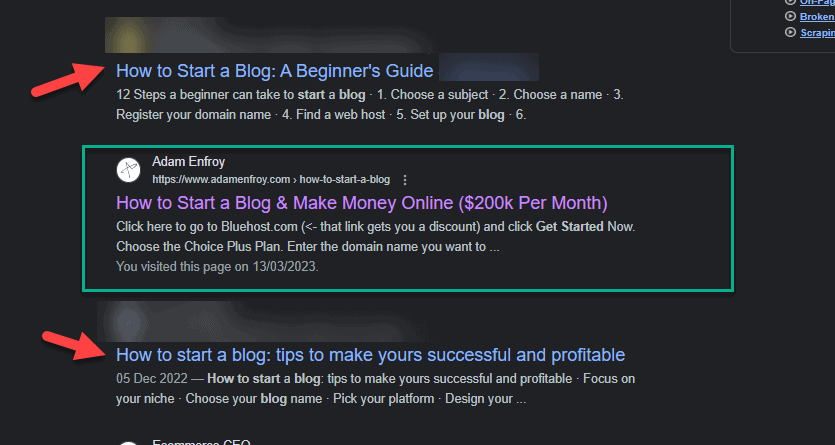
While I’m definitely biased, I think that my headline is more enticing for people to click on in the example above.
Additionally, consider adding numbers or questions to the headline.
Numbers help break up the text and clarify what information readers can expect from the article.
In addition to the headline, remember to write an attention-grabbing meta description.
The meta description appears beneath the headline when a user searches for something on Google.
It can be just as important in terms of SEO as the headline.
Ensure to include relevant keywords and keep it brief (under 160 characters).
Let’s look at some examples of what a headline could look like.
Creating a Powerful Free Landing Page Under An Hour
This headline is concise and to the point.
It promises the reader a solution to their problem by offering them a free landing page within an hour.
This type of headline is great for blog posts trying to teach readers how to complete a specific task quickly and easily.
Organize Your Life With These 20 Simple Time Management Apps
This headline is compelling because it provides readers with a clear goal and a specific number of items they can use to help them achieve it.
It also implies that these apps are easy-to-use and can help improve their lives.
This type of headline works best for blog posts focused on helping people with their daily tasks or problems.
Designing That Dream School Website Within 14 Days – Even If You’re Starting From Scratch
This title offers readers something specific and tangible – designing their dream school website.
This particular heading is very attractive for those with little web design experience who want to create something professional.
This type of headline works best for blog posts about web design or coding tutorials where you teach people how to build something from scratch.
Other blog posts that use this type of headline focus on improving people’s productivity, achieving a goal, or even making money.
Change The World Through Photography With These 7 Beginner-Friendly Hacks
This title speaks to a more aspirational crowd – those looking to change the world through photography.
This heading promises readers will learn tips and tricks to take better photos.
How To Write Captivating Content
When writing content, you must refrain from repeating yourself too often – this can make your post unprofessional and disjointed.
Take the time to check through your article for any instances of repetition and ensure that each sentence is unique and deserves to be there.
Cut out unnecessary words or phrases that may appear more than once, as this will help keep your content concise.
Check each post for grammar and spelling errors before being published.
After all, no one wants to read an article full of mistakes.
How to Enhance Your Blog Post with Visuals
As you get better at writing a blog post, you’ll want to make it even more engaging and exciting for readers.
Making the content more impactful by including visuals such as infographics, images, GIFs, and videos is a great way to add more visual interest to the post.
Enhancing a perfect blog post with visuals can also break up large chunks of text, making the article easier to read and understand.
Here are some examples of using visuals to make your blog post stand out.
- Featured Image: Every good blog post should have a featured image – this image will be used as a thumbnail when your post is shared on social media or sent in email newsletters. Go for an image that’s eye-catching, relevant to the content of your post, and preferably unique for each article.
- Images within Articles: You can also embed photos and other visuals within articles to enhance their presentation and create a more dynamic reading experience for your readers. Pictures help break up the text and make it easier for readers to follow along with what you’re saying. If you’re writing about a specific place or event, consider adding relevant images to give your readers a better understanding of what you’re talking about. These images could be anything from screenshots of websites, maps of locations, photos taken at events, or product shots of items discussed in the post.
- Photo Galleries: Another way to ensure your blog posts look professional is by creating photo galleries with relevant pictures related to whatever topic you cover in the center. These images work exceptionally well when dealing with multiple images at once. For instance, if you’re running an event recap article, having a gallery of all the photos taken at the event would add extra value for your readers.
Optimizing Your Blog For SEO
The right blog post is an effective way to generate traffic on your website, and it’s essential to ensure you are utilizing on-page search engine optimization (SEO) techniques.
SEO is essential for any website to maximize visibility and reach the largest possible audience.
While there are several steps to remember as you start crafting your next blog post, the process is quite scientific.
In addition to using relevant keywords, it’s essential to understand the appropriate length for a blog post.
The idea is that when people search for something online, they want comprehensive information.
They want more than just a brief overview of the topic – they want an in-depth look.
Not only does this help to ensure the quality of your content, but it also helps ensure that your article will rank higher in search engine results as people finish their search by consuming the articles on your site.
A tool like Surfer SEO can help you analyze your website, optimize it for better visibility, and track its performance.
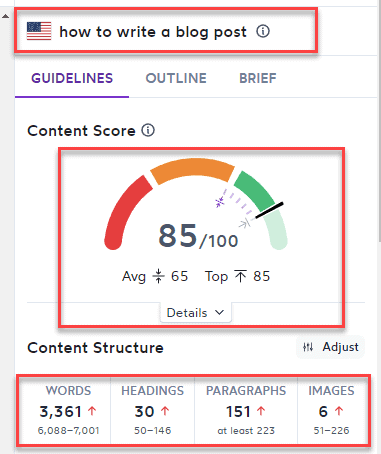
The Power of Calls-to-Action in Blogging
The call to action (CTA) is one of the most powerful tools for driving engagement in blogging.
A CTA gives readers a clear direction on what to do after reading your post and can be used to encourage them to take a specific action.
Using copywriting strategically can also convince readers that taking the desired action is in their best interest.
A CTA tells your reader what action you want them to take, whether it’s to comment on a post, email their own experience with a product or service, or sign up for an email list.
Writing great content is essential for any blog, but you must be specific when getting people to take the right action.
Writing quality blog posts with compelling calls to action can help create engaging content and drive accurate results for your website or business.
You don’t want to bombard readers with too many CTAs, but you also don’t want them hidden at the bottom of your post,
A good rule of thumb is to place a CTA near the end of each section in your post and then again at the very end – this will give readers multiple chances to click on it if they choose.
Other Key Tips To Consider
Here are a few other things to remember when writing a blog post.
Make Content Relatable and Practical
The best way to create content is by developing a first draft of your blog post and outlining the points you want to cover.
Writing a new blog from start to finish (in one go) can seem intimidating, but a bit of planning and a good outline will make the process much easier.
Once you have figured out the direction of the content, remember to make it relatable and practical.
People appreciate the content they can easily understand that offers realistic advice.
Keep in mind that people search for different terms when looking for content, so make sure to use keywords throughout the post.
Finally, the post title needs to be attention-grabbing and descriptive.
Researching Other Blogs & Finding Inspiration
Researching other blogs on the same topic can give you invaluable insight into who your target audience could be.
Read through some of their posts and consider the following:
- What topics interest their readers most?
- How do they write their content?
- Are there any common elements that tie all their posts together?
This data can inform how you craft content that resonates with your reader base.
Getting Feedback
For beginners that may be inexperienced in SEO blogging and content creation, getting feedback from more experienced bloggers is essential.
With software programs like Google Docs, it is easy for new bloggers to collaborate and get feedback from peers quickly.
Online forums and Facebook groups are great places to get feedback from people interested in reading or following your blog.
Moreover, find out what questions people in your niche ask and determine if there are enough requests to create content about them.
You can also get someone unfamiliar with the topic you are writing about to review it and give you feedback on how easy it was to consume.
You’ll get a unique perspective and ensure the content is well-written and accurate.
This information can provide valuable guidance on the types of content you should write about on your blog.
Use Effective Bullet Points
When crafting your article, include bullet points that provide a step-by-step guide.
Bullet points help in multiple ways.
They break up the text and make it easier for readers to digest.
Bullet points also help with self-editing (ensuring all critical points are covered) and help readers skim through your content more quickly.
Using bullet points can break down complex topics into easy-to-understand items and summarize the post for those needing smaller chunks of data.
Consider Your Introduction
Your intro paragraph should be catchy and engaging without being too lengthy.
When writing your intro, remember that it should capture the reader’s attention and make them want to read more.
Consider what kind of statement or story you can include to draw readers into your post.
It doesn’t have to be groundbreaking, but it should be interesting enough to make them want to read more.
The right hook can help set the tone for the rest of your post.
In one of his blogging quotes, Alex Taborrak said that, “…people are one click away from leaving you. So you’ve got to get to the point“.
Having the right hook can help you do just that.
How To Write A Blog Post – FAQ
How Important Is A Blog Domain For SEO?
Blog domain names aren’t the only factor that help SEO, but they can be beneficial sometimes.
Having a domain name related to the topic of your blog post can make it easier for search engines to understand what it’s about and may give you better rankings for those keywords.
Additionally, having a specific domain name related to your blog content increases credibility and helps build trust with your readers.
Is WordPress The Best Blogging Platform?
WordPress is today’s most popular and well-known content management system (CMS).
From plugin selection to user-friendly interfaces and SEO capabilities, WordPress offers a comprehensive solution for creating a website that performs well across all devices.
What Are Some Writing Tips To Help Write Better Content?
Here are some tips to help you write effectively for your blog:
- Remember to break down information into shorter chunks. Shorter paragraphs with clear headings and subheadings make your content easier to read and digest for readers.
- If you’re creating a how-to post that requires more detailed instructions, break down the content into easy-to-follow steps.
- Keeping your reader’s attention with humor, anecdotes, and storytelling is essential.
- Use stories. Stories help take the reader on a journey. Also, not every story has to be your own – you can use other people’s stories or examples relevant to the topic.
How Does One’s Writing Style Affect The Readership Of Their Blog?
Your writing style can have a lasting impression on your readers.
Ensure you use language and wording that is easy to read without being too simplistic or overly technical.
Using the correct tone and voice for your blog’s audience will create an enjoyable reading experience for them.
How Does One Deal With Writer’s Block As A Blogger?
Writer’s block can be an intimidating experience, but there are ways to overcome it.
Using AI writing tools to generate new topic ideas can be helpful, as well as getting inspired from blogs in your niche.
Taking a break and engaging in activities like reading or listening to music may also help unblock your creativity.
When writing blog posts, consider that each piece of content on your own blog is a representation of you and your brand.
Write with confidence, and don’t be afraid to express your thoughts in an opinionated way that stands out.
Why Do Clickbait Headers Get You More Readers?
Clickbait headlines are designed to catch the reader’s attention and draw them in.
These headlines often use catchy phrases and promise something exciting to compel readers to click through.
However, you don’t have to resort to sensationalism when creating a clickbait headline.
Sharpening your writing skills and using templates that appeal to the reader’s emotions are some of the best strategies for crafting effective headlines without straying too far from the truth.
How Do You Get Better When You Proofread Your Blog Posts?
Proofreading your blog posts is a crucial step in ensuring quality content.
Here are some tips to help you get better at proofreading:
- Read your post aloud; this enables you to catch mistakes you would otherwise miss.
- Check for grammar, spelling, and punctuation errors.
- Review the structure of your sentences to ensure they are clear and concise.
- Run a plagiarism checker, such as Copyscape or Grammarly, to ensure your content is original.
- Ensure that your post’s language and tone match the audience you’re trying to reach.
As you write blog posts, keep in mind the importance of crafting relevant and captivating and effective headlines.
Wrap Up.
Writing a successful blog post can be rewarding.
Creating content that engages your readers goes a long way in establishing your presence on the web.
Always be mindful of your content, and ensure the tone and voice are appropriate for your audience.
By remembering the above tips, you can create engaging, well-crafted, optimized content for human readers and SEO.
Doing so ensures your blog can reach a broad audience, helping you build your online presence.
Further reading on AdamEnfroy.com: Here are the best blog ideas and topics to consider when you’re stuck for content ideas.


